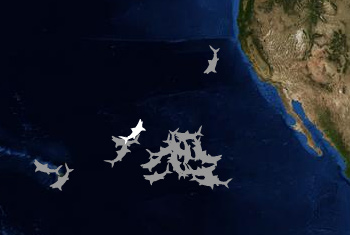Mysteries of the Great White Shark unveiled by researchers
Mysteries of the Great White Shark unveiled
Jeremy Hance, mongabay.com
February 17, 2008 [corrected 2/18]
The Great White Shark’s distinct populations never meet according to new research
|
|
The Great White Shark has always been a creature of mystery. The world’s third largest shark has long fascinated humanity from the novel and film Jaws to recent sumptuous footage of the sharks catching sea lions in Planet Earth. The behemoth, who at times can reach seven meters in length, has also become famous for occasionally attacking swimmers and surfers, though scientists believe the sharks do not intentionally hunt humans. However, the great predator’s behavior and lifecycle remains mostly mysterious to science. Some of these mysteries are just now being unraveled thanks to the Tagging of Pacific Predators (TOPP) program.
TOPP uses satellite tracking and acoustic sensors to keep tabs on 100 White Shark individuals (the official name of the Great White Shark) off the California Coast. The sharks hunt the rich waters for seals and sea lions, but the research recorded that their movements extend far from the prey-filled coasts.
Every winter the sharks leave California’s coast for one of two destinations. A minority of sharks head to the Hawaiian Island chain. The majority, however, congregate in a part of the open ocean halfway from California and Hawaii, 1,300 miles from land. Researchers have yet to uncover what attracts the shark to this particular spot. During these journey the sharks will occasionally dive up to a quarter-mile beneath the surface and stay at this depth, where light barely penetrates, for hours. On returning to California, the sharks display remarkable site-fidelity, always heading to the same area of coast they left before. “These animals appear again and again at very specific areas,” Salvador Jorgensen says, a postdoctoral researcher at Stanford University’s Hopkins Marine Station and the Monterey Bay Aquarium
 Image of tagged sharks during the summer of 2006 from the Tagging of Pacific Predators (TOPP) program |
This discovery has led researchers to a remarkable understanding of White Shark movements and populations. White Sharks are not only found off of California, there are sizeable populations off the coasts of South Africa and Australia as well. With the understanding of white shark’s movements in California, scientists now believe that these shark populations never mix, possibly creating three genetically unique populations of White Sharks. New research by TOPP has already proven some genetic differences between Australian and Californian White Sharks. A possible fourth population lives near Guadalupe Island, which lies 150 miles from Mexico’s Baja California peninsular; it is unknown whether these sharks mix at all with their northern cousins, since none of them have been tracked.
White Sharks are listed as vulnerable by the IUCN. Although mostly left alone by commercial fisheries, some individuals pursue the shark for its jaws, teeth, and fins for international trade, mostly as souvenirs. It is also, perhaps surprisingly considering its size, often caught as by-catch. One of the major difficulties regarding White Shark conservation is the lack of available census populations. Jorgenson sees hope considering these new findings: “This is really important in terms of management, so that management can focus on these population units. And this really sets the stage for us to census the population, now that we know it is a confined population in the eastern Pacific.”
TOPP was begun in 1999 and has focused on more than just White Sharks. In total 3,000 predators have been tagged, including Leatherback Turtles, Northern Bluefin Tuna, Elephant Seal, the Shortfin Mako Shark, the Salmon Shark, and even the Black-Footed Albatross. Information on several more species from the Sperm Whale to the Humboldt Squid will be available soon.
CORRECTION: This article inaccurately stated that the Great White Shark is the world’s largest shark. The Whale Shark is the world’s largest shark, followed by the Basking shark. Thanks To Nick S. and Dru for catching this error.